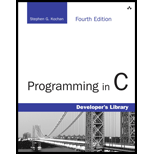
Variables:
A variable is a name given to the storage memory; the variables are declared with a data-type which represents the type of data needs to be stored in the variable.
- It contains a value which is to be stored in the memory.
- Those values are then used in a program and they undergo a set of operations.
Example:
int number = 10;
In the above line,
- The “int” represents the data type of the variable.
- The “number” represents the name of the variable.
- The “10” represents the value of the variable.
Rules to naming a variable:
To name a variable, it should undergo certain criteria; they are as follows:
- A variable name should not start with any numeric digits.
- The keywords are not to be named as a variable name.
- A variable does not include any special characters.
- A variable can contain alphabets, digits and underscore.
The variables that do not meet the above criteria are considered as illegal variables.
Explanation of Solution
Identifying the illegal variables:
Consider the variable “Int”,
- It is a legal variable, because a variable name can be a string.
Consider the variable “char”,
It is an illegal variable, because a char is a data type.
Consider the variable “6_05”,
- It is an illegal variable, because a variable name should not start with any numeric values.
Consider the variable “Calloc”,
It is a legal variable, because a variable name can be a string.
Consider the variable “Xx”,
It is a legal variable, because a variable name can be a string.
Consider the variable “alpha_beta_routine”,
It is a legal variable, because a variable name can be a string.
Consider the variable “floating”,
It is a legal variable, because a variable name can be a string.
Consider the variable “_1312”,
- It is an illegal variable, because a variable name should not start with any numeric values or underscore values.
Consider the variable “z”,
It is a legal variable, because a variable name can be a single character.
Consider the variable “ReInitialize”,
- It is a legal variable, because a variable name can be a string.
Consider the variable “_”,
- It is an illegal variable, because a variable name should not start with underscore values.
Consider the variable “A$”,
- It is an illegal variable, because a variable name should not contains special character.
Therefore, in the given variables, the illegal variables are “char”, “6_05”, “_1312”, “_” and “A$”.
Want to see more full solutions like this?
- I need help in explaining how I can demonstrate how the Laplace & Inverse transformations behaves in MATLAB transformation (ex: LIke in graph or something else)arrow_forwardYou have made the Web solution with Node.js. please let me know what problems and benefits I would experience while making the Web solution here, as compared to any other Web solution you have developed in the past. what problems and benefits/things to keep in mind as someone just learningarrow_forwardPHP is the server-side scripting language. MySQL is used with PHP to store all the data. EXPLAIN in details how to install and run the PHP/MySQL on your computer. List the issues and challenges I may encounter while making this set-up? why I asked: I currently have issues logging into http://localhost/phpmyadmin/ and I tried using the command prompt in administrator to reset the password but I got the error LOCALHOST PORT not found.arrow_forward
- Programming Logic & Design ComprehensiveComputer ScienceISBN:9781337669405Author:FARRELLPublisher:Cengage
 Microsoft Visual C#Computer ScienceISBN:9781337102100Author:Joyce, Farrell.Publisher:Cengage Learning,
Microsoft Visual C#Computer ScienceISBN:9781337102100Author:Joyce, Farrell.Publisher:Cengage Learning, EBK JAVA PROGRAMMINGComputer ScienceISBN:9781337671385Author:FARRELLPublisher:CENGAGE LEARNING - CONSIGNMENT
EBK JAVA PROGRAMMINGComputer ScienceISBN:9781337671385Author:FARRELLPublisher:CENGAGE LEARNING - CONSIGNMENT  C++ Programming: From Problem Analysis to Program...Computer ScienceISBN:9781337102087Author:D. S. MalikPublisher:Cengage Learning
C++ Programming: From Problem Analysis to Program...Computer ScienceISBN:9781337102087Author:D. S. MalikPublisher:Cengage Learning EBK JAVA PROGRAMMINGComputer ScienceISBN:9781305480537Author:FARRELLPublisher:CENGAGE LEARNING - CONSIGNMENT
EBK JAVA PROGRAMMINGComputer ScienceISBN:9781305480537Author:FARRELLPublisher:CENGAGE LEARNING - CONSIGNMENT Programming with Microsoft Visual Basic 2017Computer ScienceISBN:9781337102124Author:Diane ZakPublisher:Cengage Learning
Programming with Microsoft Visual Basic 2017Computer ScienceISBN:9781337102124Author:Diane ZakPublisher:Cengage Learning





